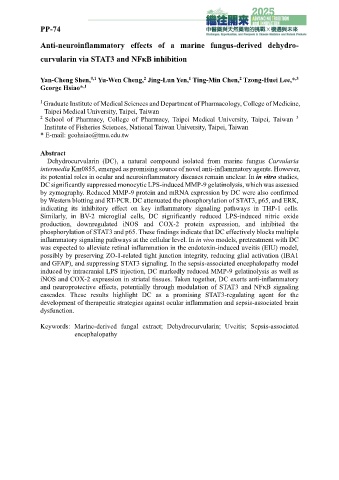Page 257 - 2025中醫藥與天然藥物聯合學術研討會-中醫藥與天然藥物的挑戰X機遇與未來大會手冊
P. 257
PP-74
Anti-neuroinflammatory effects of a marine fungus-derived dehydro-
curvularin via STAT3 and NFκB inhibition
1
#,1
2
Yan-Cheng Shen, Y u -Wen Cheng, Jing-Lun Yen, Ting-Min Chen, Tzong-Huei Lee,*
,3
2
George Hsiao* ,1
1 Graduate Institute of Medical Sciences and Department of Pharmacology, College of Medicine,
Taipei Medical University, Taipei, Taiwan
2 School of Pharmacy, College of Pharmacy, Taipei Medical University, Taipei, Taiwan 3
Institute of Fisheries Sciences, National Taiwan University, Taipei, Taiwan
* E-mail: geohsiao@tmu.edu.tw
Abstract
Dehydrocurvularin (DC), a natural compound isolated from marine fungus Curvularia
intermedia Km0855, emerged as promising source of novel anti-inflammatory agents. However,
its potential roles in ocular and neuroinflammatory diseases remain unclear. In in vitro studies,
DC significantly suppressed monocytic LPS-induced MMP-9 gelatinolysis, which was assessed
by zymography. Reduced MMP-9 protein and mRNA expression by DC were also confirmed
by Western blotting and RT-PCR. DC attenuated the phosphorylation of STAT3, p65, and ERK,
indicating its inhibitory effect on key inflammatory signaling pathways in THP-1 cells.
Similarly, in BV-2 microglial cells, DC significantly reduced LPS-induced nitric oxide
production, downregulated iNOS and COX-2 protein expression, and inhibited the
phosphorylation of STAT3 and p65. These findings indicate that DC effectively blocks multiple
inflammatory signaling pathways at the cellular level. In in vivo models, pretreatment with DC
was expected to alleviate retinal inflammation in the endotoxin-induced uveitis (EIU) model,
possibly by preserving ZO-1-related tight junction integrity, reducing glial activation (IBA1
and GFAP), and suppressing STAT3 signaling. In the sepsis-associated encephalopathy model
induced by intracranial LPS injection, DC markedly reduced MMP-9 gelatinolysis as well as
iNOS and COX-2 expression in striatal tissues. Taken together, DC exerts anti-inflammatory
and neuroprotective effects, potentially through modulation of STAT3 and NFκB signaling
cascades. These results highlight DC as a promising STAT3-regulating agent for the
development of therapeutic strategies against ocular inflammation and sepsis-associated brain
dysfunction.
Keywords: Marine-derived fungal extract; Dehydrocurvularin; Uveitis; Sepsis-associated
encephalopathy

